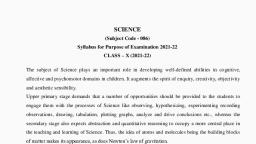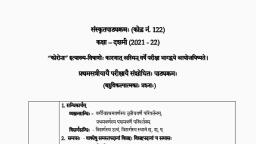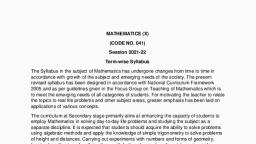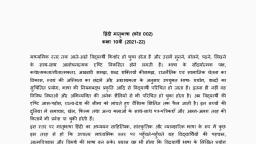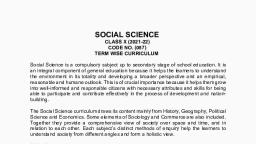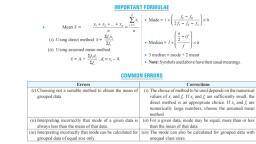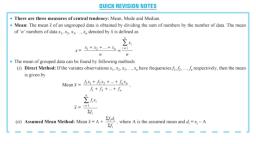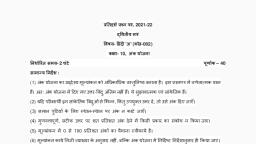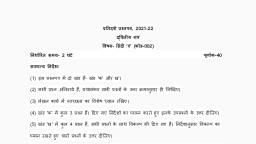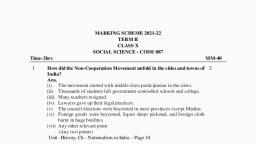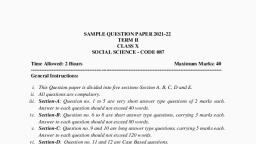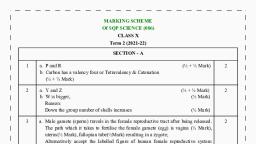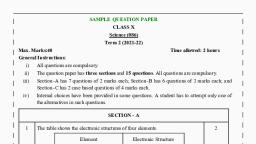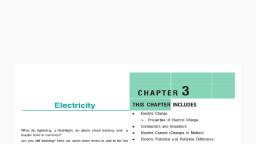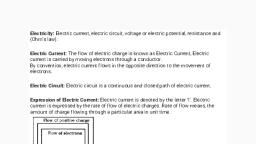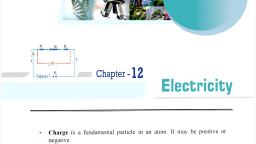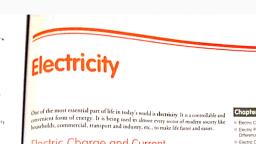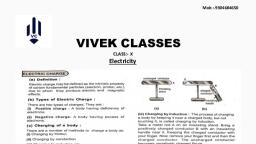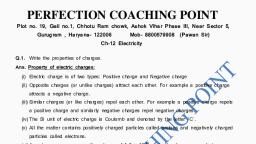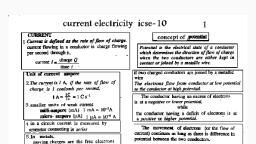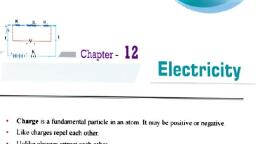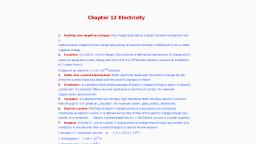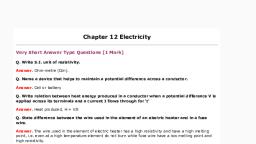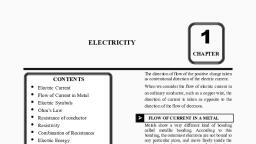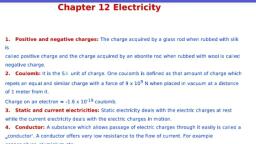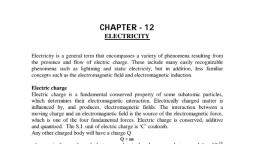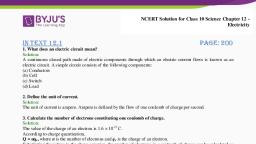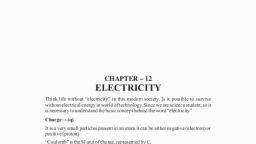Page 1 :
Chapter 12 Electricity, , 1., , Positive and negative charges: The charge acquired by a glass rod when rubbed with silk, , is, called positive charge and the charge acquired by an ebonite rod when rubbed with wool is called, negative charge., 2., , Coulomb: It is the S.I. unit of charge. One coulomb is defined as that amount of charge which, , repels an equal and similar charge with a force of 9 x 109 N when placed in vacuum at a distance, of 1 meter from it., Charge on an electron = -1.6 x 10-19 coulomb., 3., , Static and current electricities: Static electricity deals with the electric charges at rest, , while the current electricity deals with the electric charges in motion., 4., , Conductor: A substance which allows passage of electric charges through it easily is called a, , ‗conductor‘. A conductor offers very low resistance to the flow of current. For example, copper,silver, aluminium etc., 5., , Insulator: A substance that has infinitely high resistance does not allow electric current to, , flow through it. It is called an ‗insulator‘. For example rubber, glass, plastic, ebonite etc., 6., , Electric current: The flow of electric charges across a cross-section of a conductor, , constitutes an electric current. It is defined as the rate of flow of the electric charge through any, section of a conductor., 7., , Electric currentharge/Time or I = Q/t Electric current is a scalar quantity., , Ampere: It is the S.I. unit of current. If one coulomb of charge flows through any section of a, , conductor in one second, then current through it is said to be one ampere., 1 ampere = 1 coulomb/1 second, , or, , 1 A = 1C/1s = 1Cs-1, , 1 milliampere = 1 mA = 10-3 A, 1 microampere = 1µA = 10-6 A, 8., , Electric circuit: The closed path along which electric current flows is called an ‗electric, , circuit‘., 9., , Conventional current: Conventionally, the direction of motion of positive charges is taken as, , the direction of current. The direction of conventional current is opposite to that of the negatively, charged electrons., 10. Electric field: It is the region around a charged body within which its influence can be, experienced., 11. Electrostatic potential: Electrostatic potential at any point in an electric field is defined as, the amount of work done in bringing a unit positive charge from infinity to that point. Its unit is, volt. Positive charges move from higher to lower potential regions. Electrons, being negatively, charged, move from lower to higher potential regions., 12. Potential difference between two points: The Potential difference between two points in, an electric field is the amount of work done in bringing a unit positive charge from one to another., Potential difference = Work done/Charge or V = W/Q, 13. One volt potential difference: The Potential difference between two points in an electric, field is said to one volt if one joule of work has to be done in bringing a positive charge of one, coulomb from one point to another. 1 volt = 1 joule/1 coulomb or 1 V = 1J/1C, 14. Galvanometer: It is device to detect current in an electric circuit., 15. Ammeter: It is device to measure current in a circuit. It is always connected in series in a, circuit., 16. Voltmeter: It is a device to measure potential difference. It is always connected in parallel to, the component across which the potential difference is to be measured., 17. Ohm’s law: This law states that the current passing through a conductor is directly
Page 2 :
17. Ohm’s law: This law states that the current passing through a conductor is directly, proportional to the potential difference cross its ends, provided the physical conditions like, temperature, density etc. remains unchanged. V α I or V = RI, 18. Resistance: It is a property of a conductor by virtue of which it opposes the flow of current, through it. It is equal to the ratio of the potential difference applied across its ends and the current, flowing through it. Resistance = Potential difference/Current or, , R = V/I, , 19. Ohm: It is the S.I. unit of resistance. A conductor has a resistance of one ohm if a current of, one ampere flows through it on applying a potential difference of one volt across its ends., 1 ohm = 1 volt/1 ampere or 1Ω = 1V/1A, 20. Factors on which resistance of a conductor depends: The resistance R of a conductor, depends, i) Directly on its length L i.e. R α L., ii) inversely on its area of cross-section A i.e. R α 1/A, iii) on the nature of material of the conductor on. On combining the above factors, we get, R α L/A, R = ρ ×L/A, The proportionality constant ρ is called resistivity of conductor., 21. Resistivity: It is defined as the resistance offered by a cube of a material of side 1 m when, current flows perpendicular to its opposite faces. Its S.I. unit is ohm-meter (Ωm). Resistivity, ρ =, RA/L, 22. Equivalent resistance: If a single resistance can replace the combination of resistances in, such a manner that the current in the circuit remains unchanged, then that single resistance is, called the equivalent resistance., 23. Laws of resistances in series:, i) Current through each resistance is same., ii) Total voltage across the combination = Sum of the voltage drops. V= V 1 + V2 + V3, iii) Voltage drops across any resistor is proportional to its resistance. V1 = IR1 , V2 = IR2 , V2 = IR3, iv) Equivalent resistance = Sum of the individual resistances. Rs = R1 + R2 + R3, v) Equivalent resistance is larger than the largest individual resistance., 24. Laws of resistances in parallel:, i) Voltage across each resistance is same and is equal to the applied voltage. ii) Total current =, Sum of the currents through the individual resistances., I = I1 + I2 + I3, iii) Currents through various resistances are inversely proportional to the individual resistances. I1, = V/R1 1, I2 = V/R2 , I3 = V/R3, iv) Reciprocal of equivalent resistance = Sum of reciprocals of individual resistances., 1/Rp = 1/R1 + 1/R2 + 1/R3, v) Equivalent resistance is less than the smallest individual resistance., 25. Joule’s law of heating: It states that the heat produced in a conductor is directly, proportional to (i) the square of the current I through it (ii) proportional to its resistances R and, (iii) the time t for which current is passed. Mathematically, it can be expressed as, H = I2 Rt, , joule = I2 Rt/4.18 cal or, , H = VIt, , joule = VIt/4.18cal, , 26. Electric energy: It is the total work done in maintaining an electric current in an electric, circuit for given time., Electric energy, W = VIt = I2Rt joule, 27. Electrical power: Electrical power is the rate at which electric energy is consumed by an, appliance., P = W/t = VI = I2 R = V2 /R, 28. Watt: It is the S.I. unit of power. The power of an appliance is 1 watt if one ampere of current, flows through it on applying a potential differences of 1 volt across its ends., 1 watt = 1 joule/1 second =1 volt x 1 ampere or 1 W = 1 Js -1 = 1 VA 1 kilowatt = 1000 W, 29. Kilowatt hour: It is the commercial unit of electrical energy. One kilowatt hour is the electric, energy consumed by an appliance of 1000 watts when used for one hour. 1 kilowatt hour (kWh) =, 3.6 x 10 6 J







